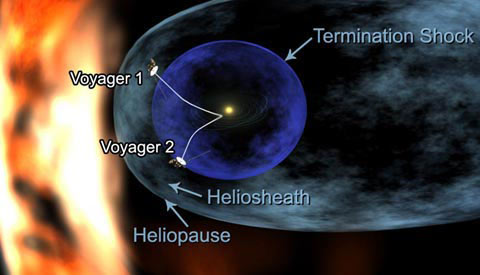Our Solar System is Squashed

SANFRANCISCO--New observations from the edge of our solar system show whatscientists have suspected for several years: The solar system is squashed.
The edge ofthe solar system is roughly where the solar wind runs up against thin gas foundbetween the stars in the rest of the Milky Way. This "wind," actually a thingas of electrically charged particles, blows outward in all directions from thesun at between 1 million and 2 million mph, forming a bubble called theheliosphere with boundaries far beyond the orbit of Pluto.
Theboundary between the heliosphere and interstellar space is an abrupt shockwave, called the solar wind termination shock. In December 2004, NASA?s Voyager 1spacecraft crossed this boundary and hinted that the shockwave was dented, oruneven in places.
Its sisterspacecraft, Voyager 2, was also launched in 1977 on a mission to the outerplanets. Voyager 2 crossed the shock boundary Aug. 30 this year, about 10billion miles away from where its twin crossed. The probe confirmed that theshock wave was squashed–it was pushed in closer to the sun by the localinterstellar magnetic field where Voyager 2 crossed compared to where Voyager 1did, by about 1 billion miles.
"So there?ssomething outside pushing in on the southern hemisphere of the heliosphere,"said Voyager mission scientist Ed Stone, that is "otherwise distorting a moreor less spherical surface."
Stone saysthis "dent" in the heliosphere is evidence of how strong theinterstellar magnetic field is.
Stone spokeduring a presentation of the research here today at a meeting of the AmericanGeophysical Union.
Breaking space news, the latest updates on rocket launches, skywatching events and more!
WhileVoyager 1 only crossed the shockwave once, Voyager 2 had multiple crossings, because the shock wave sloshes back and forth like surf on a beach. This allowed for manymeasurements of the velocity, density and temperature of the solar wind.
The datafrom Voyager2 shows that the shock wave is unusual.
In a normalshock wave, fast-moving material slows down and forms a denser, hotter regionas it encounters an obstacle. However, Voyager 2 found a much lowertemperature beyond the shock than was predicted. This probably indicates thatthe energy is being transferred to cosmic ray particles that were acceleratedto high speeds at the shock, scientists say.
So the shockbarriers acts like what Stone calls a "cosmic ray accelerator"–sort of like acosmic ping-pong game, some of the ions are reflected back across the shock.Over time, the ions gain a large amount of energy from the solar wind beforethey rocket out into space.
Scientistsare still unsure where exactly these cosmic rays originate in the shockwave–they do know that they don?t originate where either Voyager craft crossedthe shock.
BothVoyagers are currently in the heliosheath and will continue outward past thelast reaches of the sun?s wind, "and we will be then, for the first time, ininterstellar space," Stone said, with scientists hoping to use the Voyagercraft to explore space beyond our solar system.
With NASA'supcoming mission, the Interstellar Boundary Explorer (IBEX), Stone and hiscolleagues hope more variations in the shock wave will be revealed, withpossibly some effects in the east and west directions.
"Itwill tell us what it looks like from all directions," he told SPACE.com.
- Top 10 Voyager Facts
- Image Gallery: Voyager Photo Legacy
- Voyager 1 Detects Odd Shape of Solar System's Edge

Andrea Thompson is an associate editor at Scientific American, where she covers sustainability, energy and the environment. Prior to that, she was a senior writer covering climate science at Climate Central and a reporter and editor at Live Science, where she primarily covered Earth science and the environment. She holds a graduate degree in science health and environmental reporting from New York University, as well as a bachelor of science and and masters of science in atmospheric chemistry from the Georgia Institute of Technology.
